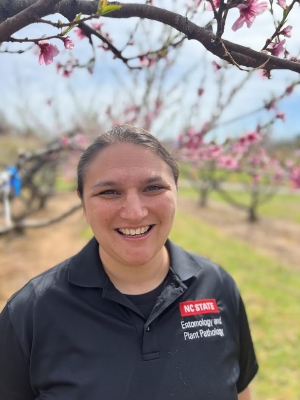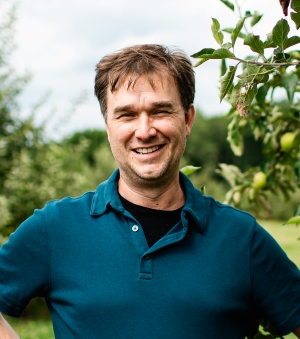This award is presented to the author or authors of published research on basic or applied aspects of diseases of perennial fruit plants (tree fruits, tree nuts, small fruits, and grapes, including tropical fruits, but excluding vegetables).
Awardees

Sara Villani was born in Raleigh, NC, and raised in Geneva, NY. She earned a B.S. degree in chemistry from SUNY at Geneseo in 2005 and a Ph.D. degree in plant pathology from Cornell University in 2016. In 2015, Villani joined the faculty of the Department of Plant Pathology at NC State University (NCSU) as an Extension assistant professor with responsibilities in tree fruit and woody ornamental pathology. In 2019, she was promoted to assistant professor in the Department of Entomology and Plant Pathology, while also assuming bunch grape and caneberry pathology responsibilities for the state.
At NCSU, Villani has developed a nationally recognized fruit and woody pathology program that utilizes a combination of fundamental and applied cross-disciplinary approaches to develop novel management solutions that are sustainable and practical for stakeholders throughout the Southeast. Research efforts in her program have largely focused on the detection of fungicide resistance and elucidating resistance mechanisms in economically consequential pathogens of apple and invesigating the biology of opportunistic fungal pathogens of apple, bunch grape, and blackberry.
Villani’s program has excelled in utilizing a variety of traditional and modern communication media for the dissemination of research-generated Extension deliverables to her stakeholders. In the past six years, she has spoken at over 120 stakeholder meetings, influencing fruit crop disease management decisions at both the national and international levels. In addition, Villani has been influential in how apple stakeholders throughout North Carolina and most of the Southeast receive timely information on management through the development of the NCSS Appalachian Apples Extension Portal, which has over 3,000 subscribers and 10,000 views annually.

Kerik Cox was born in Bloomington, IN, and grew up in rural upstate South Carolina. He received a B.S. degree from Furman University in 1998 and M.S. and Ph.D. degrees in plant pathology from the University of Georgia in 2000 and 2004, respectively. He served as a postdoctoral research and teaching associate at Clemson University from 2004 to 2006 with a focus on fruit pathology and mycology. In 2006, he joined the Geneva Department of Plant Pathology at the New York Agricultural Experiment Station at Cornell University, with an appointment of associate professor with research and Extension responsibilities for tree and small fruit pathology. Presently, Cox is an associate professor of plant pathology and plant-microbe biology in the School of Integrative Plant Sciences, with responsibilities in research, teaching, and Extension.
Cox’s principal research efforts include antimicrobial resistance (fungicides and antibiotics) and applied disease management, with a focus on chemical and biological control of pathogens of apple, stone fruit, and strawberries, with connections to entomology and horticulture. His Extension efforts focus on pesticide education, disease forecasting tools, and applied disease management, with an emphasis on production systems in apple and small fruit. Since the establishment of his program, Cox has been conducting research on applied disease management, as well as antimicrobial resistance and invasive pathogen surveys in New York and the Northeastern United States.
From 2016 to 2022, Cox was editor-in-chief of
Plant Disease Management Reports. He has also served as an associate editor (2010–2011) and senior editor (2012–2021) for Plant Disease and is currently associate editor-in-chief (2022–present).
Although both Cox and Villani have independently developed highly impactful research and Extension programs, their nomination for the Lee M. Hutchins Award reflects their contributions to improving the understanding of fungicide resistance in the apple scab pathogen,
Venturia inaequalis, while Villani was Cox’s graduate student at Cornell University. They spent the greater part of a decade defining and understanding the prevalence of practical fungicide resistance in populations of
V. inaequalis throughout the Northeastern United States. In a series of studies published in APS journals from 2013 to 2016, they developed thresholds for determining practical resistance for four single-site fungicide classes (guanidines, DMIs, QoIs, and SDHIs), established implemented protocols for rapid monitoring of resistance, characterized cross- and multi-fungicide resistance in regional populations, and worked to identify the genetic basis of resistance and its contribution to practical resistance at an orchard population level.
Villani and Cox’s resistance-screening efforts set the standard for fungicide selection for apple scab management throughout the Eastern and North Central United States, with populations of
V. inaequalis screened for resistance to four major single-site fungicide classes in over 150 commercial orchards over a 10-year period (Plant Disease 98:1122-1130;
Plant Disease 99:1526-1536;
Phytopathology 102:S4.26). The team further advanced the understanding of the association between practical fungicide resistance and molecular determinants for resistance. To better predict and detect practical resistance to QoI fungicides in populations of
V. inaequalis, Villani and Cox developed an allele-specific qPCR assay. This approach led to the conclusion that heteroplasmy of the mitochondrial
V.
inaequaliscytb gene was not responsible for the quantitative resistance responses often observed with QoI fungicides. Furthermore, improved practical resistance thresholds were developed to reflect the percentage of resistant
cytb alleles in orchard populations (Phytopathology 104:945-953). Measuring this threshold within a pooled sampling allowed early and rapid identification of QoI fungicide resistance. During their characterization of DMI and SDHI sensitivity in populations of
V. inaequalis, Villani and Cox observed that cross-resistance among fungicides in the same FRAC group was not always observed in isolates. The team discovered that resistance to difenoconazole was associated with the overexpression of the target
CYP51A1 gene caused by the upstream insertion of a repeating element having the properties of a transcriptional enhancer, whereas in isolates with myclobutanil resistance, neither the repeating element nor overexpression of the target gene was observed (Phytopathology 106:562-571).
As the work was ongoing, Villani and Cox immediately translated their fungicide resistance work into practice by offering the service free to growers, whereby growers could submit yearly diagnostic samples through a highly coordinated network of regional Extension specialists. Over the course of their efforts, more than 150 regional stakeholders received reports with specific recommendations for implementing fungicide resistance and disease management. Moreover, their work helped growers understand that practical or field resistance is not simply a matter of identifying resistant isolates, but rather an interaction of environment, cultivar, and the resistance status of the pathogen population.
